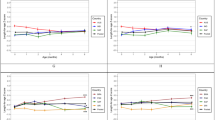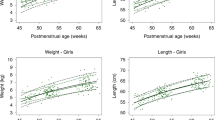Abstract
The rates and patterns of growth in weight of European and North American infants have changed over the last 100 years. Since the development and first use of growth charts for postnatal health surveillance a century ago, there appears to have been an increase in the weight of 1-year olds of about 1 kg. Taking into account the higher past rates of infant morbidity and mortality, and poorer quality of artificial feeds, this change is likely to be another expression of the secular increase in physical stature consequent on improved hygiene and nutrition. Using the new WHO (World Health Organisation) standards of infant weight growth, this secular change can be observed for both breast-fed and formula-fed babies. The slower weight growth of the former, both now and in the past compared with modern formula-fed babies, may have implications of our understanding of the risk factors for obesity and cardiovascular disease. The variability of infant growth in time and space, and the plasticity of developmental processes during the life course (fetal life, infancy, puberty and reproduction), means that the WHO infant growth standard should not alone be regarded as an ideal growth trajectory for all babies.
This is a preview of subscription content, access via your institution
Access options
Subscribe to this journal
Receive 12 print issues and online access
$259.00 per year
only $21.58 per issue
Buy this article
- Purchase on Springer Link
- Instant access to full article PDF
Prices may be subject to local taxes which are calculated during checkout


Similar content being viewed by others
References
Armstrong D (1986). The invention of infant mortality. Soc Health Ill 8, 211–232.
Baird J, Fisher D, Lucas P, Kleijnen J, Roberts H, Law C (2005). Being big or growing fast: systematic review of size and growth in infancy and later obesity. BMJ 331, 929–931.
Barker DJP, Winter PD, Osmond C, Margetts B, Simmonds SJ (1989). Weight in infancy and death from ischaemic heart disease. Lancet 2, 577–580.
Barker DJP (ed) (1992). Fetal and Infant Origins of Adult Disease. British Medical Journal: London.
Barker DJP (ed) (1994). Mothers Babies and Disease in Later Life. British Medical Journal: London.
Bateson P, Barker D, Clutton-Brock T, Deb D, D’Udine B, Foley RA et al. (2004). Developmental plasticity and human health. Nature 430, 419–421.
Brosco JP (2002). Weight charts and well child care. In: Stern AM, Markel H (eds). Formative Years: Children's Health in the United States, 188-2000. University of Michigan Press: Anne Arbor.
Budin P (1907). Le Nourrisson (trans. WJ Maloney). Caxton: London.
Camerer W (1908). Metabolism and nutrition during the first year of life. In: Pfaundler M,Schlossmann A (eds). The Diseases of Children, (trans. HL Shaw and L La Fetra). Lippincott: Philadelphia.
Cameron N, Hawley NL (2009). Should the UK use the WHO growth charts? Paediatr Child Health 20, 151–156.
Cautley E (1896). The Natural and Artificial Methods of Feeding Infants and Young Children. Churchill: London.
Clarke J (1786). Observations on some causes of the excess of the mortality of males above that of females. Philosoph Trans Roy Soc Lond 76, 349–364.
Committee on Medical Aspects of Food and Nutrition Policy (COMA) (2002). Scientific Review of the Welfare Food Scheme. TSO: London.
Corbett SS, Drewett RF (2004). To what extent is failure to thrive in infancy associated with poorer cognitive development? A review and meta-analysis. J Child Psychol Psychiatry 45, 641–654.
Davey Smith G, Kuh D (1997). Does early nutrition affect later health? Views from the 1930s and 1980s. In: Smith EF (ed). Science, Scientists and Politics in the Twentieth Century. Routledge: London.
de Onis M, Garcia C, Onyango AW, Borghi E (2007). Comparison of the WHO child growth standards with the CDC 2000 growth charts. J Nutr 137, 144–148.
Dingwall-Fordyce A (1908). Diet in Infancy. William Green: London.
Elsom R, Weaver LT (1999). Does breastfeeding beyond one year benefit children? Fet Mat Med Rev 11, 163–174.
Forsdahl A (1977). Are poor living conditions in childhood and adolescence an important risk factor for atherosclerotic heart disease? Br J Prev Soc Med 31, 91–95.
Freeman JV, Cole TJ, Chinn S, Jones PRM, White EM, Preece MA (1995). Cross sectional stature and weight reference curves for the UK, 1990. Arch Dis Child 73, 17–24.
Friedlander M (1815). De l’Education Physique de L’Homme. Treuttel et Würtz: Paris.
Gairdner D, Pearson J (1971). A growth chart for premature and other infants. Arch Dis Child 46, 783–787.
Gluckman PD, Hanson MA (2006). Developmental Origins of Health and Disease. Cambridge University Press: Cambridge.
Gluckman PD, Hanson MA, Bateson P, Beedle A, Law CM, Bhutta Z et al. (2009). Towards a new developmental synthesis: adaptive developmental plasticity and human disease. Lancet 373, 1654–1657.
Holt LE (1899). The Diseases of Infancy and Childhood. Thomas Lewin: London.
International Pediatric Association (2006). Endorsement of the New WHO Growth Standards for Infants and Young Children. IPA: Geneva.
Jelliffe DB, Jelliffe EFP (1978). Human Milk in the Modern World. Oxford University Press: Oxford.
Kintner HJ (1987). The impact of breastfeeding patterns on regional differences in infant mortality in Germany, 1910. Eur J Pop 3, 233–261.
Kramer MS, Guo T, Platt RW, Shapiro S, Collet J-P, Chalmers B et al. (2002). Breastfeeding and infant growth: biology or bias? Pediatrics 110, 343–347.
Kuh D, Davey Smith G (1993). When is mortality risk determined? Historical insights into a current debate. Soc Hist Med 6, 101–123.
La Berge AB (1991). Medicalization and moralization: the crèches of nineteenth-century Paris. J Soc Hist 25, 65–87.
Mackenzie WL, Foster A (1907). The Physical Condition of Children Attending the Public Schools of the School Board of Glasgow. Corporation of City of Glasgow: Glasgow.
Marmot MG, Wilkinson R (eds) (2006). Social Determinants of Health 2nd edn. Oxford University Press: Oxford.
Matthews JR (1995). Quantification and the Quest for Medical Certainty. Princeton University Press: Princeton.
McCance RA, Widdowson EM (1974). The determinants of growth and form. Proc R Soc Lond (Ser B) 185, 1–17.
McCleary GF (1933). The Early History of the Infant Welfare Movement. Lewis & Co.: London.
McKeown T (1988). The Role of Medicine: Dream, Mirage or Nemesis. Princeton University Press: Princeton.
Meckel RA (1990). Save the Babies. Johns Hopkins University Press: Baltimore.
Monteiro POA, Victora CG (2005). Rapid growth in infancy and childhood and obesity in later life—a systematic review. Obesity Rev 6, 143–154.
National Center for Health Statistics (2000): www.cdc.gov/growthcharts.
Newman G (1906). Infant Mortality. Methuen: London.
Osmond C, Barker DJP, Winter PD, Fall CHD, Simmonds SJ (1993). Early growth and death from cardiovascular disease. BMJ 307, 1519–1524.
Parliamentary papers (1904). Report of the Interdepartmental Committee on Physical Deterioration. HMSO: London.
Paton N, Findlay L (1926). Poverty, Nutrition and Growth. MRC Special Report 101. HMSO: London.
Pearson K (1912). The intensity of natural selection in man. Proc R Soc Lond (Ser B) 85, 469–476.
Pritchard E (1904). The Physiological Feeding of Infants. Kimpton: London.
Quetelet A (1830). Sur la taille moyenne de l’homme dans les villes et dans les campagnes, et sur l’age ou la croissance est complètement achevée. Ann Hyg Pub 3, 24–26.
Quetelet A (1831). Recherches sur la loi de croissance de l’homme. Ann Hyg Pub 6, 89–113.
Razzell P, Spence C, Vines K (2004). Poverty, birth weight and infant weight gain in Hertfordshire, 1923-1939. Internat J Epidemiol 33, 1228–1233.
Robertson TB (1916). Studies on the growth of man. Am J Physiol 41, 535–546.
Robertson TB (1923). Growth and development. In: Abt IA (ed). Pediatrics. WD Saunders: Philadelphia.
Rollet C (1997). The fight against infant mortality in the past: an international comparison. In: Bideau A, Desjardins B, Brignoli H (eds). Infant and Child Mortality in the Past. Clarendon Press: Oxford.
Rotch TM (1896). Pediatrics. Lippincott: Philadelphia.
Routh CHF (1860). Infant Feeding and its Influence on Life. John Churchill: London.
Russow A (1880). Vergleichende beobachtungen über den einfluss der ern ährung mit der brust und der künstlichen ernährung auf das gewicht und den wuchs der kinder. Jahrbuch für Kinerheilkunde 16, 86–131.
Schmid-Monnard K (1892). Über den Einfluss des Militärdienstes der Väter auf die Körperliche Entwicklung ihrer Nachkommenschaft. Jahrbuch Kinderheilkunde 33, 327–350.
Singhal A, Lucas A (2004). Early origins of cardiovascular disease. Is there a unifying hypothesis? Lancet 363, 1642–1645.
Singhal A (2006). Early nutrition and long-term cardiovascular health. Nutr Rev 64, S44–S49.
Singhal A, Kennedy K, Lanigan J, Fewtrell M, Cole TJ, Stephenson T et al. (2010). Nutrition in infancy and long-term risk of obesity: evidence from two randomized controlled trials. Am J Clin Nutr 92: 1133–1144.
Tanner JM, Whitehouse RH (1973). Height and weight charts from birth to five years allowing for length of gestation. Arch Dis Child 48, 786–789.
Tanner JM (1988). A History of the Study of Human Growth. Cambridge University Press: Cambridge.
Tempkin O (1956). Soranus's Gynecology. Johns Hopkins Press: Baltimore.
Variot G, Fliniaux I (1914). Tables des croissance comparés des nourissons élevés au sein et au biberon durant la premi ère année de la vie’. Comptes Rend Acad Sci (Paris) 158, 1361–1364.
Villermé LR (1828). Mémoire sur la mortalité en France dans le classe aisé et dans le classes indigente. Mém Acad Roy Méd 1, 51–98.
Weaver LT (2006a). Rapid growth in infancy: balancing the interests of the child. J Pediatr Gastroenterol Nutr 43, 428–432.
Weaver LT (2006b). The emergence of our modern understanding of infant nutrition and feeding 1750–1900. Curr Paediatr 16, 342–347.
Weaver LT (2009). ‘Growing Babies’: Defining the Milk Requirements of Infants 1890–1910. Soc Hist Med 23, 320–337.
Weaver LT (2010). In the balance weighing babies and the birth of the infant welfare clinic. Bull Hist Med 84, 30–57.
World Health Organization (2006): www.who.int/childgrowth/standards.
World Health Organization (2009). WHO Child Growth Standards and the Identification of Severe Acute Malnutrition in Infants and Children. WHO and UNICEF: Geneva.
Wright C (2005). Growth charts for babies. BMJ 330, 1399–1400.
Wunderlich CRA (1871). On the Temperature in Diseases: A Manual of Medical Thermometry. (trans. WB Woodman) New Sydenham Society: London.
Acknowledgements
I thank Malcolm Nicolson and Angus Ferguson from the Centre for the History of Medicine, and Charlotte Wright of the PEACH Unit, University of Glasgow and the Wellcome Trust for their help and support.
Author information
Authors and Affiliations
Corresponding author
Ethics declarations
Competing interests
The author has been a consultant for Danone Baby Nutrition, SMA and the WHO.
Rights and permissions
About this article
Cite this article
Weaver, L. How did babies grow 100 years ago?. Eur J Clin Nutr 65, 3–9 (2011). https://doi.org/10.1038/ejcn.2010.257
Received:
Revised:
Accepted:
Published:
Issue Date:
DOI: https://doi.org/10.1038/ejcn.2010.257



